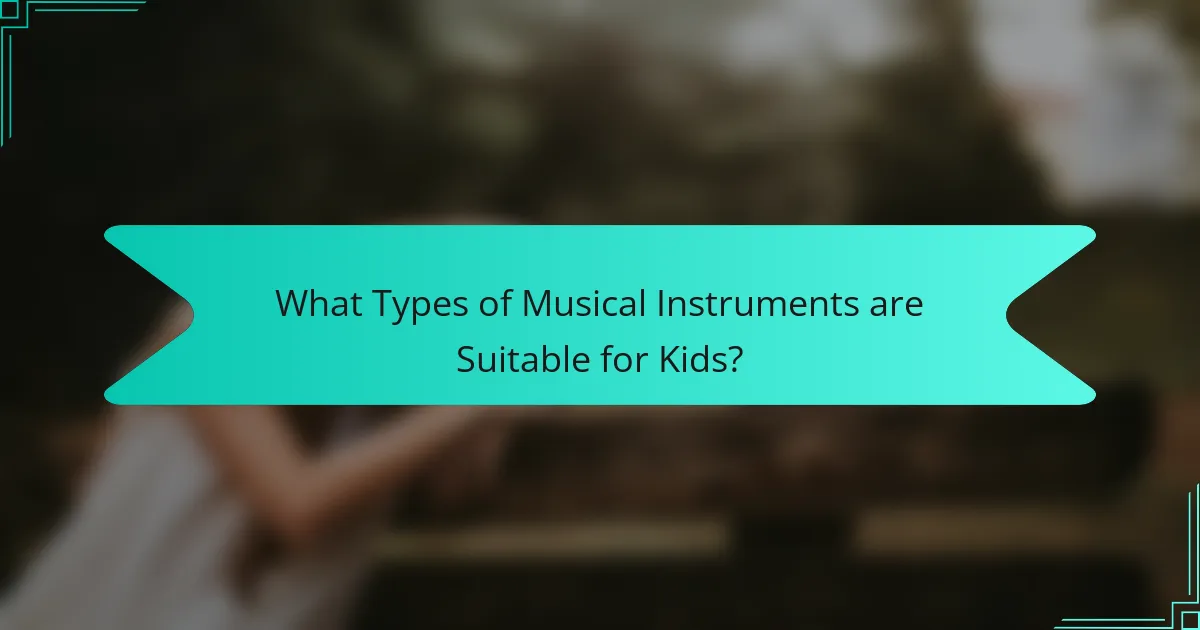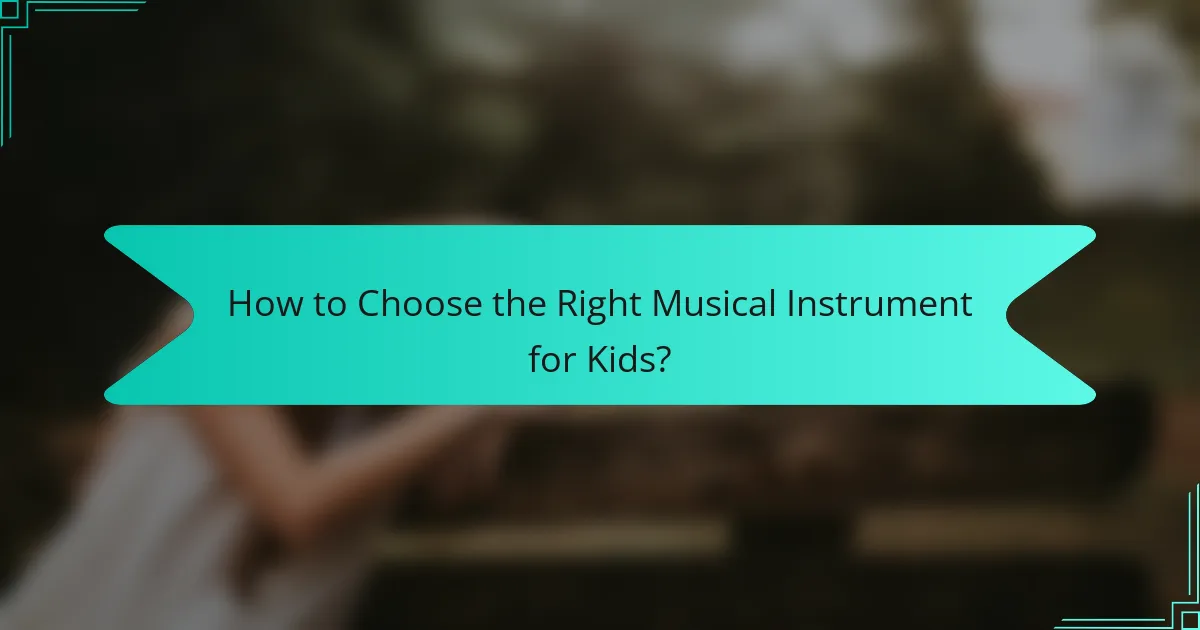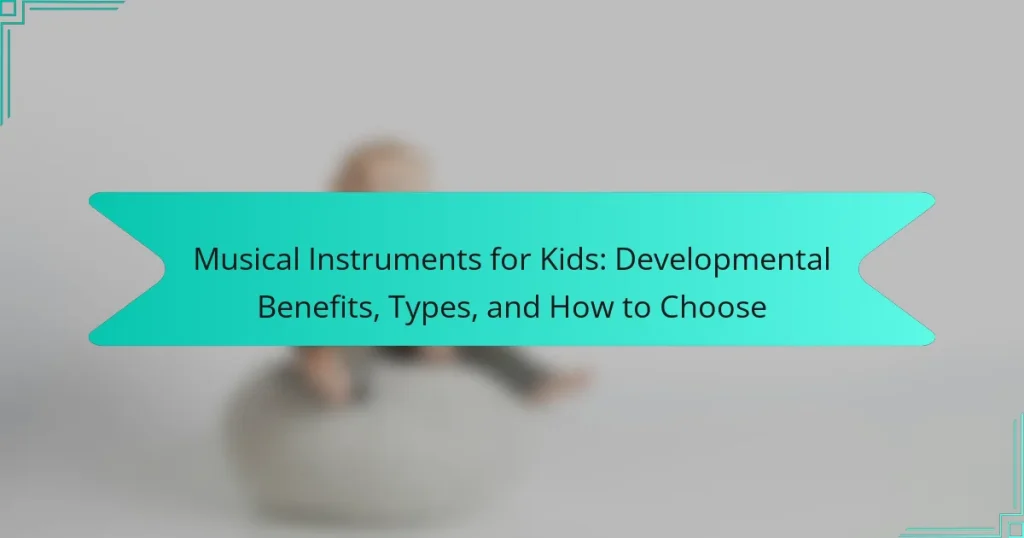Musical instruments for kids are specially designed tools that allow children to create and enjoy music, including drums, xylophones, and keyboards. These instruments are made from safe, lightweight materials to accommodate young users and support the development of skills such as fine motor abilities, hand-eye coordination, and auditory perception. The article explores various types of instruments—percussion, string, and wind—and their unique benefits for children’s growth. Additionally, it provides guidance on selecting the appropriate instrument based on a child’s age, interests, and physical capabilities, emphasizing the importance of comfort and manageability in the learning process.

What are Musical Instruments for Kids?
Musical instruments for kids are tools designed for children to create and enjoy music. These instruments include items like drums, xylophones, and keyboards. They are often made from safe, lightweight materials suitable for young users. Musical instruments help develop various skills in children. These include fine motor skills, hand-eye coordination, and auditory skills. Research shows that music education can enhance cognitive abilities and social skills. Instruments for kids are available in various sizes and styles to cater to different age groups. They often come in bright colors to engage children’s interest.
How do Musical Instruments support child development?
Musical instruments support child development by enhancing cognitive, emotional, and social skills. Playing instruments improves memory and attention span. Research indicates that music training can lead to better academic performance. It also fosters creativity and self-expression. Children learn discipline and patience through practice. Additionally, music promotes social interaction and teamwork in group settings. Studies show that musical engagement can boost confidence and self-esteem. Overall, musical instruments play a vital role in holistic child development.
What cognitive skills can be enhanced through playing musical instruments?
Playing musical instruments can enhance various cognitive skills. These skills include memory, attention, and problem-solving abilities. Learning to play an instrument requires memorizing notes and rhythms. This process strengthens memory retention and recall. Attention is improved as musicians must focus on multiple elements simultaneously. This includes reading music, timing, and finger placement. Problem-solving skills are enhanced through improvisation and adapting to challenges in music. Research supports these claims, showing that musical training positively impacts cognitive development in children. A study published in the journal “Psychological Science” found that music training correlates with improved verbal memory and literacy skills.
How do musical instruments promote social skills among children?
Musical instruments promote social skills among children by encouraging teamwork and communication. When children play in groups, they learn to listen to one another. This interaction fosters cooperation and helps them understand social cues. Playing music together requires synchronization and shared goals. These experiences enhance their ability to work with others. Research indicates that group music activities improve social behavior in children. A study by H. R. K. L. et al. in 2018 found that music participation significantly boosts social interaction skills. Thus, engaging with musical instruments effectively nurtures children’s social development.
Why is it important for kids to learn music?
Learning music is important for kids because it enhances cognitive development. Engaging with music improves memory, attention, and language skills. Studies show that children who learn music perform better academically. For example, research from the University of California found that music training correlates with higher math scores. Additionally, music fosters emotional expression and social skills. Kids involved in music often develop teamwork and communication abilities. Overall, music education provides a well-rounded foundation for personal and academic growth.
What emotional benefits do children gain from playing instruments?
Children gain several emotional benefits from playing instruments. Playing instruments enhances self-esteem and confidence. Children experience a sense of achievement when they learn new pieces. This accomplishment fosters a positive self-image. Additionally, music provides an emotional outlet for expression. Children can convey feelings that they may struggle to articulate verbally. Playing in groups also nurtures social skills and teamwork. Collaborative music-making creates a sense of belonging. Research shows that music participation correlates with reduced anxiety and stress levels. Overall, playing instruments significantly contributes to emotional well-being in children.
How can music education influence academic performance?
Music education can significantly enhance academic performance. Studies show that students involved in music tend to score higher on standardized tests. For example, a research study by the Arts Education Partnership found that students engaged in music education showed improved math and reading scores. Music education fosters skills such as discipline, focus, and teamwork. These skills translate well into academic settings. Furthermore, learning an instrument can improve memory and cognitive abilities. This is supported by research from the University of California, which indicates that music training can lead to higher IQ levels. Overall, music education plays a vital role in boosting academic success.

What Types of Musical Instruments are Suitable for Kids?
Percussion instruments, string instruments, and wind instruments are suitable for kids. Percussion instruments include tambourines, maracas, and drums. These instruments help develop rhythm and coordination. String instruments like ukuleles and violins are also appropriate. They enhance fine motor skills and musical understanding. Wind instruments such as recorders and harmonicas are beginner-friendly. They promote breath control and lung capacity. Each type of instrument offers unique benefits for children’s development.
What are the most common types of musical instruments for children?
The most common types of musical instruments for children include keyboards, percussion instruments, and string instruments. Keyboards, such as pianos and electronic keyboards, are popular for their versatility and ease of learning. Percussion instruments, like drums and tambourines, engage children through rhythm and movement. String instruments, including violins and ukuleles, introduce children to melody and harmony. These instruments are often chosen for their accessibility and ability to foster musical skills at a young age. Research shows that early exposure to music can enhance cognitive development in children.
What are the characteristics of string instruments for kids?
String instruments for kids are designed to be lightweight and easy to handle. They typically have smaller sizes compared to [censured] instruments. This makes them more accessible for young learners. Common types include violins, cellos, and ukuleles.
These instruments often feature softer strings, which are easier on young fingers. Many beginner models use synthetic or nylon strings for comfort. The body shape is often rounded to facilitate playability. Additionally, they may have bright colors or fun designs to engage children.
String instruments for kids also usually come with simplified tuning mechanisms. This helps young players learn to tune their instruments more easily. Many models are made from durable materials to withstand rough handling.
How do percussion instruments cater to young learners?
Percussion instruments cater to young learners by enhancing their motor skills and coordination. These instruments require physical engagement, which promotes hand-eye coordination. Playing percussion also aids in developing rhythm and timing, essential skills for musical understanding. The tactile nature of these instruments encourages exploration and creativity. Instruments like drums and tambourines are accessible and easy to play. They provide immediate auditory feedback, which reinforces learning through repetition. Studies indicate that early exposure to music improves cognitive abilities in children. Engaging with percussion can foster social skills through group play and collaboration.
What factors should be considered when selecting a musical instrument for a child?
Consider the child’s age and size when selecting a musical instrument. Instruments should be appropriate for their physical development. For example, smaller instruments like the ukulele may suit younger children. Assess the child’s interests and preferences. Engaging with an instrument they enjoy increases motivation. Evaluate the instrument’s playability and ease of learning. Instruments that are too complex may discourage practice. Look into the instrument’s durability and maintenance needs. Instruments for children should withstand rough handling. Consider the cost and availability of lessons. Affordable instruments with accessible instruction are beneficial. Finally, involve the child in the selection process. Their enthusiasm can lead to a more positive musical experience.
How does a child’s age influence instrument choice?
A child’s age significantly influences instrument choice. Younger children, typically ages 3-5, often benefit from smaller instruments like ukuleles or xylophones. These instruments are lightweight and easier to handle. As children grow, around ages 6-8, they may transition to instruments like recorders or beginner pianos. These options help develop coordination and musical understanding.
By ages 9-12, children may choose more complex instruments like guitars or violins. At this stage, they often have the physical strength and cognitive skills to learn challenging techniques. Research shows that age-appropriate instruments enhance engagement and learning outcomes. For instance, a study by the National Association for Music Education indicates that early exposure to music correlates with improved cognitive skills. Therefore, age is a crucial factor in determining suitable instruments for children.
What skill levels should parents consider when choosing instruments?
Parents should consider three skill levels when choosing instruments: beginner, intermediate, and advanced. Beginner instruments are designed for children just starting their musical journey. They are typically easier to play and understand. Intermediate instruments cater to children who have developed basic skills and are ready for more complexity. Advanced instruments are suited for skilled young musicians who require more nuanced techniques. Selecting the appropriate skill level ensures that children remain engaged and motivated in their musical education.

How to Choose the Right Musical Instrument for Kids?
To choose the right musical instrument for kids, consider their age, interests, and physical capabilities. Younger children may benefit from smaller instruments like a ukulele or keyboard. Older kids might prefer instruments such as guitars or violins. Assess the child’s interest in specific types of music. This can guide you toward instruments that align with their preferences. Evaluate the physical size and weight of the instrument. It should be manageable for the child to hold and play comfortably. Look into the instrument’s learning curve. Some instruments are easier for beginners, such as percussion instruments. Lastly, consult with music educators for recommendations based on the child’s unique traits.
What steps should parents take when selecting an instrument?
Parents should consider several steps when selecting an instrument for their child. First, assess the child’s interest and enthusiasm for music. This can guide the choice of instrument. Next, consider the child’s age and physical size. Some instruments are more suitable for smaller children. Evaluate the instrument’s playability and comfort. Instruments like keyboards and ukuleles are often easier for beginners. Research the instrument’s educational benefits. Instruments can enhance cognitive skills and coordination. Finally, explore options for rental or purchase. Renting can be a cost-effective way to start.
How can parents assess their child’s interest in music?
Parents can assess their child’s interest in music by observing their reactions to music and musical activities. Engaging children in music-related play can reveal their preferences. Parents should note if their child enjoys singing, dancing, or playing with musical instruments. Asking children about their favorite songs or artists can provide insights into their musical inclinations. Enrolling them in music classes can help gauge their enthusiasm and commitment. Additionally, parents can encourage them to explore different genres to see what resonates. Tracking their engagement over time can indicate a sustained interest in music.
What role do music lessons play in instrument selection?
Music lessons significantly influence instrument selection. They provide students with foundational skills and knowledge about different instruments. Through lessons, students can explore various instruments and determine their preferences. Instructors often guide students toward instruments that match their interests and abilities. This personalized approach helps in selecting an instrument that fosters engagement and motivation. Research indicates that early exposure to music education enhances decision-making in instrument choice. Therefore, music lessons play a critical role in shaping a child’s instrument selection process.
What are some tips for encouraging children to play musical instruments?
Encouraging children to play musical instruments can be achieved through various strategies. First, introduce instruments early to spark interest. Children exposed to music from a young age are more likely to engage. Second, make practice fun and engaging. Incorporating games or rewards can motivate children. Third, provide opportunities for social interaction through group lessons or ensembles. This can enhance their enjoyment and commitment. Fourth, lead by example. Children often mimic adults, so playing an instrument yourself can inspire them. Lastly, celebrate their progress, no matter how small. Positive reinforcement builds confidence and encourages continued effort.
How can parents create a supportive environment for music practice?
Parents can create a supportive environment for music practice by establishing a consistent schedule. A regular practice time helps children develop discipline. Providing a dedicated space for practice enhances focus and minimizes distractions. Ensuring access to quality instruments is essential for effective learning. Encouragement and positive reinforcement motivate children to improve. Parents should actively listen and engage with their child’s music. Attending performances together fosters a sense of community and belonging. Research indicates that parental involvement significantly boosts children’s musical achievement.
What resources are available for parents to help children learn music?
Parents can access various resources to help children learn music. These resources include online platforms like YouTube, which offers tutorials and lessons. Music education apps, such as Yousician and Simply Piano, provide interactive learning experiences. Local music schools and community centers often offer classes for children. Additionally, books on music theory and instrument techniques can serve as valuable learning tools. Parents can also find free sheet music online for practice. Online forums and communities can connect parents with other music educators and enthusiasts. These resources collectively support children’s musical education and development.
Musical instruments for kids are specially designed tools that facilitate music creation and enjoyment among children. This article explores the developmental benefits of musical instruments, highlighting their role in enhancing cognitive, emotional, and social skills. It categorizes suitable instruments by type, including percussion, string, and wind instruments, and provides guidance on selecting the right instrument based on a child’s age, interests, and skill level. Additionally, it offers practical tips for encouraging children to engage with music and resources available to support their learning journey.




